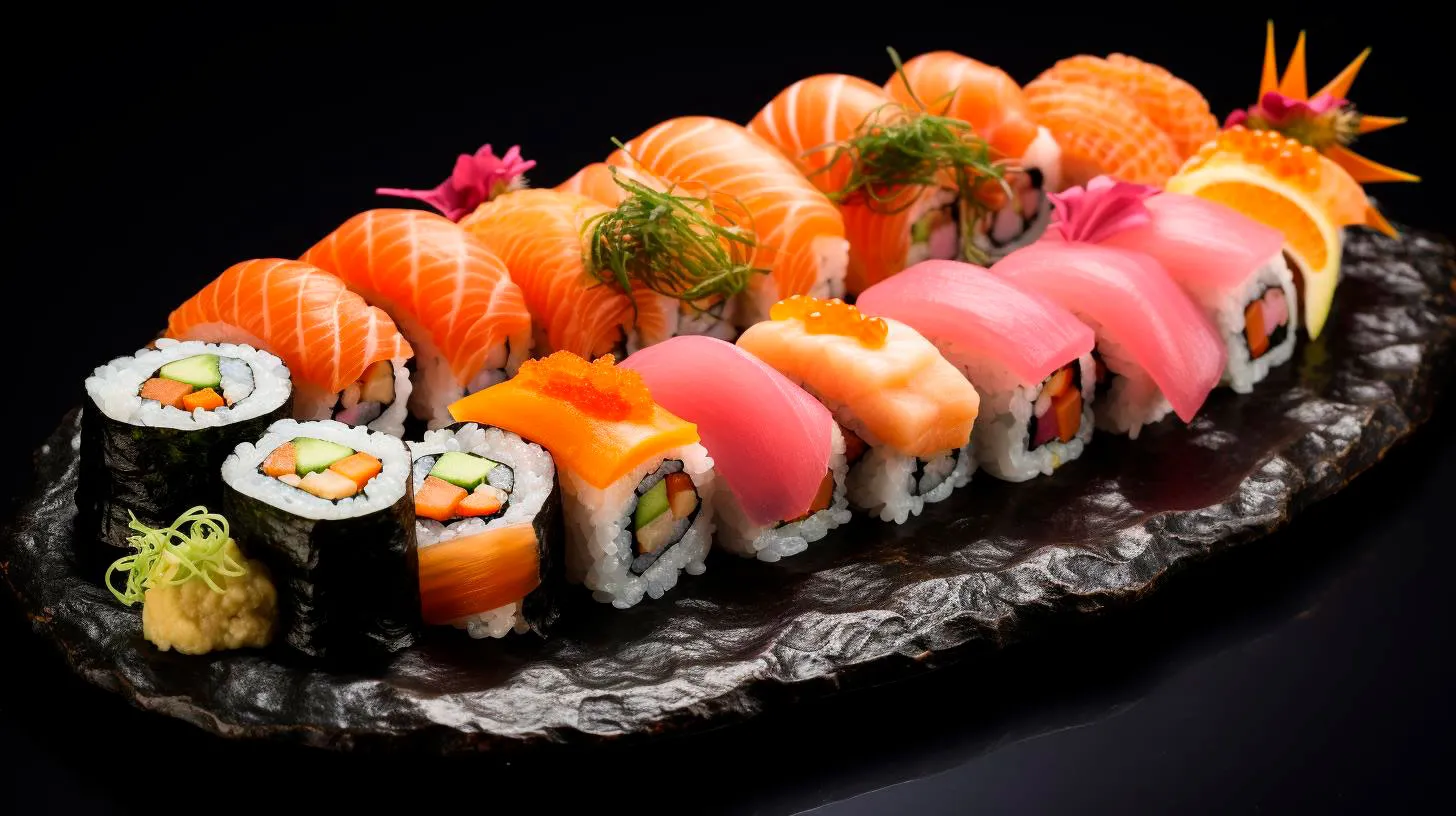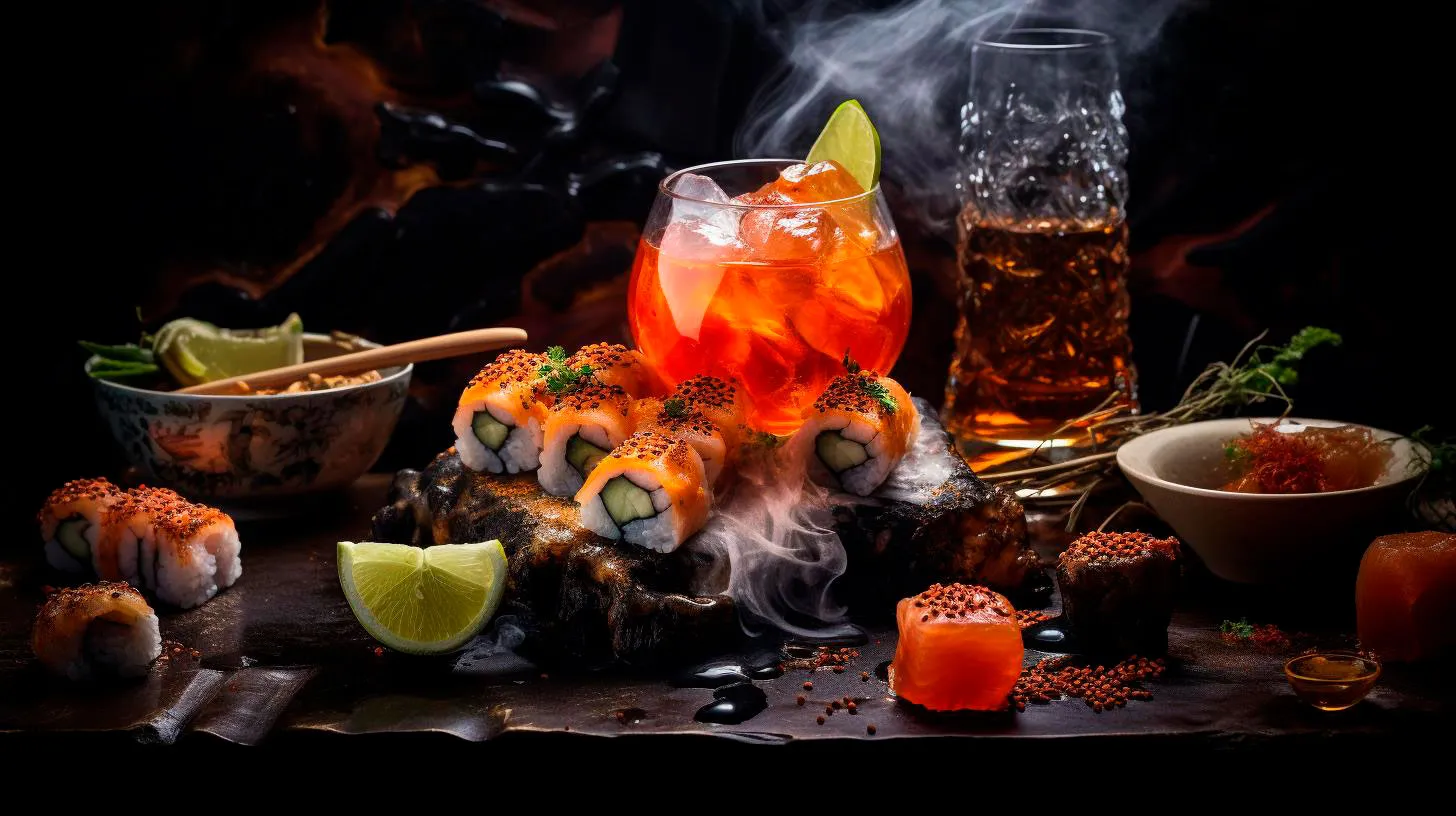The Art of Sushi Presentation
In this article, we will delve into the art of sushi presentation, exploring its significance, techniques, and how it enhances the overall enjoyment of this Japanese delicacy.
The Significance of Sushi Presentation
The saying “we eat with our eyes first” holds true in the world of sushi. Presentation plays a vital role in making a lasting impression on diners. The visual appeal of sushi entices and enthralls, setting the stage for a delightful culinary journey. Here are a few reasons why sushi presentation is of utmost importance:
- Enhances Aesthetics: Sushi presentation transforms the ingredients into edible artwork. Delicate garnishes, colorful arrangements, and precise cuts showcase the chef’s skill and creativity, making each plate a work of art.
- Reflects Quality and Freshness: Well-presented sushi demonstrates the freshness and premium quality of the ingredients used. A beautifully assembled sushi roll suggests attention to detail and the chef’s dedication to providing an exceptional dining experience.
- Elevates the Dining Experience: Sushi presentation sets the tone for the entire meal. The visual allure of each dish creates excitement, anticipation, and a heightened appreciation for the flavors that follow. It immerses the diners in a multisensory experience.
Techniques for Impressive Sushi Presentation
Creating visually stunning sushi requires a combination of technical skills and an artistic eye. By adopting the following techniques, chefs can take their sushi presentation to the next level:
Color Composition:
Colors play a vital role in sushi presentation. A well-balanced combination of vibrant hues not only makes the dish visually appealing but also adds depth and complexity to the overall presentation. Key points to consider:
- Use a variety of colorful ingredients such as fresh fish, vegetables, and garnishes.
- Consider the color wheel to create visually pleasing combinations. Complementary colors, such as orange and blue or green and red, can create a captivating contrast.
- Balance warm and cool tones to achieve a harmonious palette that complements the flavors of the sushi.
Form and Texture:
Varying the form and texture of sushi components adds visual interest and enhances the overall experience. Here’s how to incorporate form and texture effectively:
- Experiment with different shapes, such as rolls, nigiri, or temari sushi, to create visual diversity on the plate.
- Consider the texture of the ingredients – incorporate crisp vegetables, soft fish, and smooth sauces to create a pleasing contrast.
- Utilize different cutting techniques, such as diagonal cuts or decorative scoring, to add intriguing patterns and textures to the sushi.
Plating Techniques:
The presentation of sushi goes beyond the actual sushi itself. Attention should be given to the plate, as it serves as the canvas for the edible artwork. Here are some plating techniques to consider:
- Choose appropriate plates that complement the colors and style of the sushi dish. Traditionally, ceramic or lacquerware plates are favored for their elegant simplicity.
- Use negative space wisely – strategically leave empty areas on the plate to highlight the sushi and create a sense of balance.
- Consider adding garnishes, such as microgreens, edible flowers, or sesame seeds, to enhance the overall presentation without overpowering the flavors.
Key Takeaways
Sushi presentation is a vital aspect of the overall dining experience, captivating diners with its visual allure and enhancing the appreciation of the flavors that follow. When done thoughtfully, sushi presentation:
- Showcases the chef’s skill, creativity, and attention to detail.
- Reflects the quality, freshness, and premium nature of the ingredients used.
- Elevates the dining experience through visual stimulation and anticipation.
- Uses techniques such as color composition, varied form and texture, and strategic plating to create visually stunning sushi dishes.
Remember, sushi is not just about taste – it is an art form that engages all the senses. The next time you savor a sushi meal, take a moment to appreciate the impeccable presentation, for it adds a whole new dimension to your culinary adventure.
Savoring the Delicate Craftsmanship of Sushi Rolls
In this article, we will dive into the world of sushi rolls, exploring their history, types, and the precise techniques involved in their creation.
The History and Evolution of Sushi Rolls
Sushi, which literally means “sour-tasting,” has a rich history dating back over 1,000 years in Japan. Initially, sushi was created as a preservation method for fish. Uncooked rice was used as a means to preserve the fish by fermentation. Over time, the technique evolved, and sushi began to be consumed with the rice itself.
During the 19th century, a significant shift occurred when sushi chefs in Tokyo started experimenting with new ingredients and methods. Makizushi, or sushi rolls, were born out of this innovation. Traditionally, sushi rolls consist of seaweed, called nori, wrapped around a filling of vinegary rice and various toppings.
Today, sushi rolls have evolved into an art form, with an array of creative combinations and artistic presentations that cater to different tastes and preferences.
Types of Sushi Rolls
Sushi rolls come in a variety of types, each offering a unique blend of flavors and textures. Here are a few popular examples:
1. Maki Roll:
- A basic sushi roll with the seaweed on the outside and a variety of fillings, such as vegetables, fish, or seafood, on the inside.
- Often served with soy sauce, wasabi, and pickled ginger.
2. Nigiri:
- A hand-pressed sushi roll consisting of a small mound of vinegared rice topped with fresh fish or seafood.
- Commonly eaten with minimal soy sauce to enhance the natural flavors of the ingredients.
3. Temaki:
- A cone-shaped sushi roll with the seaweed acting as the outer layer.
- Often filled with a combination of rice, fish, vegetables, and sauces.
- Can be easily held and enjoyed as a hand-held sushi snack.
The Art of Sushi Roll Making
Creating the perfect sushi roll requires precision, skill, and attention to detail. Sushi chefs, also known as Itamae, undergo years of rigorous training to master the techniques involved. Here are a few key steps involved in sushi roll making:
1. Preparation:
- Gather the necessary ingredients, including fresh fish, vegetables, seaweed, and sushi rice.
- Cut the ingredients into precise shapes and sizes for optimal taste and presentation.
2. Rolling:
- Place a sheet of nori on a bamboo rolling mat.
- Spread a layer of sushi rice evenly over the nori, leaving a small space at the top for sealing.
- Arrange the desired fillings on top of the rice.
- Roll the bamboo mat tightly, applying gentle pressure to form a compact sushi roll.
3. Cutting:
- Using a sharp knife, cut the sushi roll into bite-sized pieces.
- Ensure clean, precise cuts to maintain the aesthetic appeal of the roll.
The Unique Pleasure of Sushi Rolls
Indulging in sushi rolls offers a multitude of pleasures beyond the taste itself. Here are a few key takeaways to savor and appreciate about sushi rolls:
1. Health Benefits:
- Sushi rolls often include nutrient-rich ingredients like fresh fish, vegetables, and seaweed.
- Seaweed contains high levels of minerals and vitamins, including iodine, calcium, and iron.
- Fish such as salmon and tuna are excellent sources of omega-3 fatty acids.
2. Visual Delight:
- Sushi rolls are known for their appealing and artistic presentation.
- The vibrant colors of the ingredients create an aesthetically pleasing dining experience.
3. Cultural Experience:
- Exploring sushi rolls allows you to immerse yourself in the rich Japanese culinary tradition.
- Understanding the history and techniques behind sushi rolls adds depth to the dining experience.
In conclusion, sushi rolls are a magnificent gift from Japanese cuisine, offering an enticing mix of flavors, textures, and visual appeal. Their delicate craftsmanship, coupled with the fusion of fresh ingredients, creates a culinary experience unlike any other. So, the next time you savor a sushi roll, take a moment to appreciate the artistry and skills involved in its creation, as you embark on a gastronomic journey into the world of this exquisite delicacy.
The Art of Sushi Presentation
From meticulous plating to creative garnishes, sushi artisans have transformed sushi from a simple dish to a work of art. In this article, we will explore the art of sushi presentation, its importance, and how it enhances the dining experience.
The Importance of Sushi Presentation
In the world of culinary arts, presentation is as crucial as taste. When it comes to sushi, presentation can make or break the first impression. Aesthetically pleasing sushi not only captures attention but also stimulates the appetite. Here are some key reasons why sushi presentation is of utmost importance:
- Aesthetic Appeal: Presenting sushi in an aesthetically pleasing manner enhances the visual appeal, enticing diners to try it. Colors, shapes, and arrangement all contribute to an eye-catching presentation.
- Cultural Significance: Sushi presentation reflects the rich Japanese culture and history. Each element, from the choice of ingredients to the arrangement, contributes to conveying a story and honoring tradition.
- Perception of Quality: Well-presented sushi gives the impression of freshness, quality, and skillful craftsmanship. It instills confidence in the chef’s abilities and elevates the overall dining experience.
The Art of Sushi Presentation Techniques
Mastering the art of sushi presentation requires skill, precision, and creativity. Sushi chefs meticulously select and arrange ingredients to create visually stunning plates. Here are some common techniques used in sushi presentation:
Balance and Harmony
One fundamental principle of sushi presentation is achieving a harmonious balance between colors, textures, and flavors. The colors of the ingredients are carefully chosen to create contrast and emphasize freshness. The arrangement of different textures, such as soft fish and crunchy vegetables, adds dimension to the sushi roll.
Garnishes and Edible Art
Garnishes play a vital role in sushi presentation, adding decorative elements and enhancing the overall visual appeal. Sushi chefs often utilize fresh herbs, edible flowers, and thinly sliced vegetables to create intricate patterns or designs. These edible artworks not only beautify the dish but also provide additional flavors and textures.
Plating Techniques
Choosing the right plate and arranging sushi rolls attractively can greatly impact the overall presentation. Chefs often use different shapes and sizes of plates to complement the sushi’s design. Additionally, carefully crafted arrangements, such as flower-like shapes or symmetrical patterns, contribute to an impeccable presentation.
The Impact on the Dining Experience
Sushi presentation is much more than just visual appeal; it enhances the dining experience as a whole. Here are some key takeaways on how the art of sushi presentation impacts the overall experience:
- Sensory Stimulation: A beautifully presented plate of sushi stimulates not only the sense of sight but also cravings and anticipation. It creates excitement and heightens the sensory experience of eating sushi.
- Enhanced Appreciation: Thoughtfully presented sushi allows diners to appreciate the craftsmanship and effort that goes into each piece. It fosters a deeper connection with the food and an increased appreciation for the culinary art.
- Memorable Experience: Sushi presentation creates a memorable dining experience, leaving a lasting impression on guests. Beautifully presented sushi is often shared on social media, promoting the restaurant and attracting new customers.
In conclusion, the art of sushi presentation is an integral part of the overall dining experience. It reflects the meticulous craftsmanship, cultural significance, and attention to detail of sushi chefs. By mastering the techniques of balance, garnishes, and plating, sushi artisans transform sushi into a visual masterpiece. So, the next time you enjoy sushi, take a moment to appreciate the artistry behind its presentation and savor the flavors that unfold with each bite.
Unveiling the Secrets of Sushi Mastery
In this article, we will dive deep into the art of sushi making and unveil the secrets behind sushi mastery.
The Art of Sushi Making
Creating sushi is not just about placing raw fish and rice together; it is an art form that requires precision, technique, and an understanding of flavors. A sushi master, also known as an itamae, spends years perfecting their skills to create a culinary masterpiece.
Here are some key takeaways when it comes to the art of sushi making:
- Knife Skills: A sushi master’s most important tool is their knife. Their expert knife skills allow them to slice fish with precision, ensuring the perfect texture and flavor.
- Fresh and High-Quality Ingredients: To create exceptional sushi, it is crucial to use the freshest and highest quality ingredients. From the fish and rice to the seaweed and vegetables, each component must be carefully selected.
- Rice Preparation: The rice in sushi plays a vital role in its taste and texture. Sushi masters understand the art of preparing the perfect sushi rice, which involves proper washing, seasoning, and cooking techniques.
- Balance of Flavors: A well-crafted sushi roll is all about balance. The itamae carefully blends flavors, textures, and colors to create a harmonious dining experience.
The Advantages of Sushi Mastery
Becoming a sushi master not only brings personal fulfillment but also opens up various professional opportunities. Let’s explore the advantages of sushi mastery:
- Career Growth: With the increasing popularity of sushi worldwide, there is a high demand for skilled sushi chefs. Mastering the art of sushi can lead to exciting career prospects, including working at renowned restaurants or even opening your own sushi bar.
- Cultural Appreciation: Sushi mastery allows individuals to delve into the rich and fascinating world of Japanese culture. Understanding the history, traditions, and techniques behind sushi enhances the overall appreciation of this culinary art.
- Creativity and Innovation: While traditional sushi techniques are essential, a sushi master also has the freedom to experiment and create innovative sushi creations. This allows for endless possibilities and the chance to leave your unique mark in the culinary world.
Key Takeaways for Sushi Enthusiasts
For sushi enthusiasts eager to learn the secrets of sushi making, here are some key takeaways:
- Appreciate the Ingredients: When enjoying sushi, take a moment to savor the freshness and quality of the ingredients. Each piece tells a unique story.
- Observe the Itamae: Sit at the sushi bar and observe the itamae’s techniques and precision. This not only provides insight into their mastery but also enhances the overall dining experience.
- Try New Flavors: Don’t shy away from trying different types of sushi. Venture beyond the traditional tuna and salmon and explore the world of uni, eel, or even vegetarian sushi. You might discover new favorites!
In conclusion, sushi mastery is a journey that requires dedication, skill, and passion. From knife skills to flavor combinations, a sushi master’s expertise is honed over time. Whether you aspire to become a sushi chef or simply appreciate the art, unveiling the secrets behind sushi mastery allows for a deeper understanding and admiration for this exceptional cuisine.



